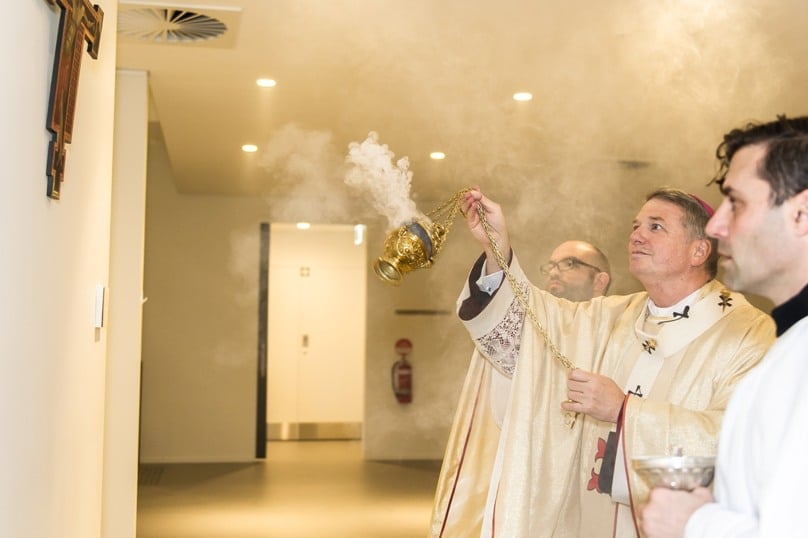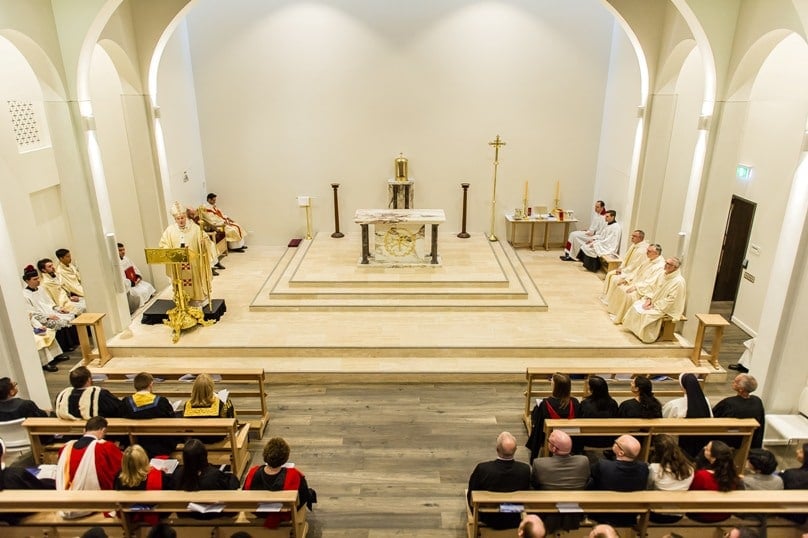Today we celebrate the Mass of Blessing of the St John Paul II Chapel, the dedication of the altar, and the opening and blessing of the John Paul the Great Catholic Centre in the University of Sydney. When I was reading arts and laws in this university, I often attended Mass at the old Chapel of the Resurrection on this site or dropped in to pray when I was over this side of campus for economics classes.

We didn’t have anything so grand as the University of Sydney business school then, but we did have two, often warring economics departments to match the two always warring philosophy departments! The pool was over this side and Wentworth, of course, so there were various drawcards. But nothing so grand as this truly beautiful Catholic chaplaincy.
So it gives me great pleasure to return to my alma mater three and a half decades later, to bless this chapel, altar and centre. As many here know, it’s an ancient Christian practice to seal the relics of saints in altars, recalling those early centuries when the persecuted Church celebrated Mass in catacombs upon the graves of martyrs. And so, during a recent sojourn to Kraków, I asked the Archbishop, Cardinal Stanisaw Dziwisz, former private secretary of Pope John Paul II, for a relic of the saint to seal within this altar and happily he obliged. I am also wearing today vestments the saint wore on his visits to this country.
On 8 April, 2005, six days after his death, Karol Józef Wojtya was buried. It was not your average funeral: it was the largest gathering of heads of state in history, surpassing the funerals of kings, presidents, Princess Diana, even Winston Churchill; it included leaders of many other faiths; and it drew together the largest number of mourners in history, more than four million mourners present there in Rome, with hundreds of millions connected through television, the internet or contemporaneous Requiems the world over.
The largest media contingent ever gathered for anything in history was there for the funeral and subsequent conclave, and they were overwhelmingly sympathetic. Catholics like litanies – long lists of names of God, the Blessed Virgin and the saints by which we ask their help.
After all, no one tag adequately captures or invokes them. Yet it was secular leaders and journos who immediately got to work on an unwitting litany to John Paul. In headlines they named him: “Actor-athlete turned scholar-pope”, “Destroyer of communism and Champion of freedom”, “Advocate of peace and reconciliation”, “Champion of the civilisation of love” and “Enemy of the culture of death”, “Friend of the poor, Voice of the voiceless”, “Force for Christian unity”, “Friend of Jews and Muslims”, “Father of World Youth Day”, “Apostle of the new evangelisation”, “Millennial pope and Faithful servant of God”. The most common name was the shortest: “John Paul the Great”.
[su_audio url=”https://www.xt3.com/library/view.php?id=18119&categoryId=36&episodeId=2290″]
He’s not the first to get the title The Great. Kings have had it, such as the Old Testament Antiochius of the Selucids and the New Testament Herod I of Judea. We think of Alexander of Macedon, Charles of the Franks, Alfred of England and Catherine of the Russias. Of humbler rank were the bishop-theologian St Basil of Caesarea, the Dominican scientist-philosopher St Albert, the father of modern India ‘the Great’ Gandhi – and of course Gonzo the Great from the Muppets. Two popes of the first millennium had the title: Gregory I and Leo I. But only one has had it by popular acclaim in the subsequent millennium: John Paul II.
In our Gospel today, Peter declares the faith of the Church and Christ responds by commissioning him and his successors to be keepers of the keys, binder-loosers, judge-absolvers, guardians of the Gospel (Mt 16:13). Popes ever since have done this in different ways. Perhaps we call John Paul ‘Great’ because he did it in so many different ways – so expansively, so comprehensively. Here in the university we honour him as a scholar and published philosopher-theologian long before he was pope.
As pope his teachings filled more metres of book-shelves than all his predecessors put together, and ranged across many subjects.
As a pastor he led a Church of a billion people through turbulent times for two and a half decades and went out to those people, travelling more than 1.1 million km around the world, including thrice to Sydney, twice as pontiff.
At home he revolutionised the internal operations and external relationships of the Holy See. His preaching and diplomacy helped end the tyranny of communism in Eastern Europe and Russia and so the Cold War.
His advocacy for the weak brought him into contest with the Western powers, too, as he critiqued capitalist democracies that lack compassion for the unborn, poor and foreigners. He became a champion of human life and its cradles marriage, family and a truly civil society.
His stance for Catholic faith and morals made him a prophetic and divisive figure at times; but he could also be a great reconciler, as he worked to bring together Eastern and Western Christians, contending European powers, or the economically divided North and South.
He apologised to those the Church had hurt and sort to defeat old enemies by making them friends. John Paul II led the Church and the world confidently but humbly from the 20th and bloodiest of centuries into a new century with hope and vision; with an assurance we are not doomed to repeat the world wars, genocides and massacres of innocents; with a challenge to respect the dignity and rights of everyone, share our affluence with the needy, and honour God above all.
Young people might call him ‘Great’ because he was so obviously their friend. His capacity to be close to them was already evident when, in the shadows of Nazis and Communists, he joined youth drama groups and a clandestine seminary, and later worked as priest, lecturer and youth chaplain. The students called him Wujek – Uncle – and they regularly joined him for trips that involved skiing, hiking or camping with conversations about the meaning of life and decades of the rosary. As archbishop and pope he made sure he still had opportunities to hear and talk to young people.
His was the invention of World Youth Day, that draws together the young in unabashed Catholic celebrations every few years somewhere in the world including once in this fair city and on this university campus.
Not that JP2 romanticised young people or pandered to them: he expected a lot from them, set the bar high, and challenged them to a full-on humanity and a full-cream Catholicism. He knew youth is the time for settling identity and ideals, when conscience is tested, and sexuality and relationships developed or deformed. He knew these had to be treasured if young people were to grow into their personal vocations, which are always expressions of the core vocation to love.
Uncle John Paul knew what young people need; that they long for identity and truth; and so their university years can truly graced times of seeking and finding. When visiting the University of Sydney in 1986 and meeting representatives of Australian tertiary institutions, he underlined the centrality of truth to the academic task. He argued that the pursuit of truth is what makes the university a genuine service of humanity and even a divine service, revealing something of the mystery of man and so of the God in whose image we are made.

In his great encyclical Fides et Ratio he returned to the theme of the community of scholars and the gift that they can be to humanity.
Universities, he believed, are about more than maximising enrolments and degrees, augmenting employment opportunities and salaries, or achieving benchmarks and research quotas. They exist to serve “the vocation of truth”, to inspire inquiry into the deeper questions, enable the pursuit of answers wherever they are to be found, and, however humbly, partially, inadequately at times, allow us to embrace the truth for ourselves.
Our ceremonies today acknowledge the vocation of truth in the university setting.
Here at this altar, the surrounding chapel, and the concentric circles of the chaplaincy building and the mission to the university that goes out from it, the Catholic Chaplaincy will build on the long and fruitful history of the Church as the originator of the very idea and first examples of the university and as long-time chaplains to this one.
In the last decade alone at least five young men from our Sydney Chaplaincies have been ordained to the priesthood, at least 18 more are in seminary or religious formation, and at least twelve young women in religious life. Who knows how many have embarked upon the adventures of marriage and parenthood?
Who knows, too, how many are making major contributions to Church and society through the things they have learnt in the university and the wisdom, inspiration and support received through chaplaincy.
In a few moments I will continue the baptism in holy water, the confirmation with sacred chrism, first holy communion and ordering of this chapel to its sacred purpose, as a house of prayer and worship, and as a centre where young people may bring their questions to God and seek wisdom and direction.
I pray that young people will find here an Uncle in John Paul the Great, a brother in his Lord Jesus Christ, and a mother in His Holy Church, all leading them to true happiness in this life and eternal happiness in the truth in the next life.
May all those who use this splendid centre contribute to the building up of Church and society as Paul described for us in our epistle (1Cor 3:911, 16-17). St John Paul the Great, pray for us! All Holy Men and Women, pray for us!
This is an edited version of the homily given by Archbishop Anthony Fisher at the Mass of Blessing of the St John Paul II Chapel in the University of Sydney on 16 September.
